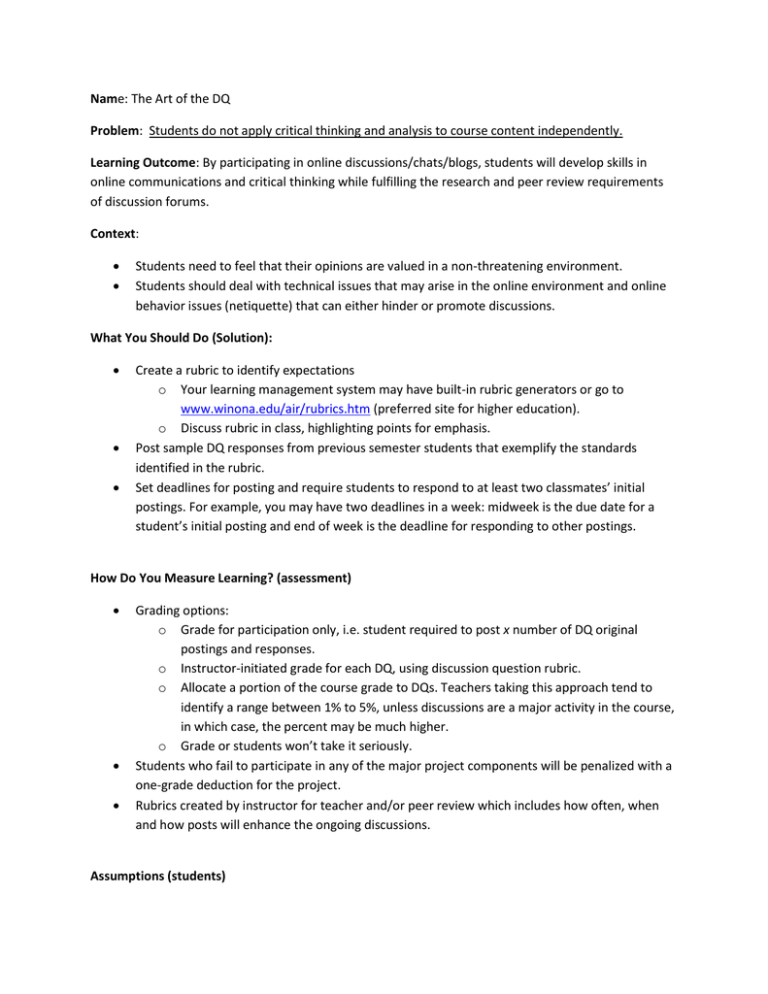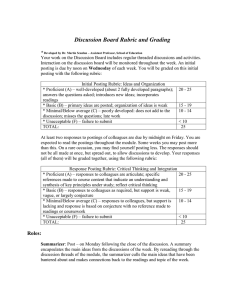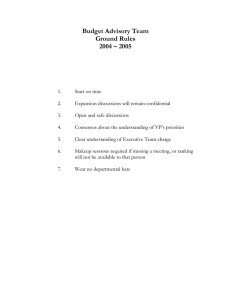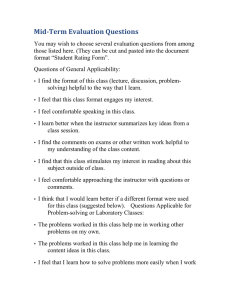Nam Problem Learning Outcome
advertisement

Name: The Art of the DQ Problem: Students do not apply critical thinking and analysis to course content independently. Learning Outcome: By participating in online discussions/chats/blogs, students will develop skills in online communications and critical thinking while fulfilling the research and peer review requirements of discussion forums. Context: Students need to feel that their opinions are valued in a non-threatening environment. Students should deal with technical issues that may arise in the online environment and online behavior issues (netiquette) that can either hinder or promote discussions. What You Should Do (Solution): Create a rubric to identify expectations o Your learning management system may have built-in rubric generators or go to www.winona.edu/air/rubrics.htm (preferred site for higher education). o Discuss rubric in class, highlighting points for emphasis. Post sample DQ responses from previous semester students that exemplify the standards identified in the rubric. Set deadlines for posting and require students to respond to at least two classmates’ initial postings. For example, you may have two deadlines in a week: midweek is the due date for a student’s initial posting and end of week is the deadline for responding to other postings. How Do You Measure Learning? (assessment) Grading options: o Grade for participation only, i.e. student required to post x number of DQ original postings and responses. o Instructor-initiated grade for each DQ, using discussion question rubric. o Allocate a portion of the course grade to DQs. Teachers taking this approach tend to identify a range between 1% to 5%, unless discussions are a major activity in the course, in which case, the percent may be much higher. o Grade or students won’t take it seriously. Students who fail to participate in any of the major project components will be penalized with a one-grade deduction for the project. Rubrics created by instructor for teacher and/or peer review which includes how often, when and how posts will enhance the ongoing discussions. Assumptions (students) Students are comfortable “living “ in online forums. Extending this activity to an academic setting provides a linkage to real world issues. Time is an issue with students and a barrier to being a full participant in the discussions process, especially when responding to others’ postings. Students find the process more beneficial and engaging when a number of perspectives and opinions are reflected in the forum. Students need to feel safe (respectful and open postings) in online discussions. Students may actually favor group discussions with a reasonably sized group and assigned roles (facilitator, researcher, summarizer, and questioner). Assumptions (course design) Learning management systems provide rubric tools for both instructor use and peer review application. Instructor presence in the course is demonstrated through weekly announcements and frequent discussion postings. Questions are designed to be open-ended so as to avoid stifling opinions. Instructor communicates in a positive tone. This is accomplished through the use of emoticons to convey tone and language that encourages student participation. Make sure students understand the instructor’s role in the discussions. Teachers may play the devil’s advocate, so students should understand that the views being expressed are not necessarily those of the teacher. The online discussion topic must be interesting. Higher participation results from questions that have relevancy to students, connecting to either their immediate lives or to their future. Encourage timely participation. As an option, during the first week of class, have the students define the parameters. Model for students how to write for online dialogue. Optional: use video clips to prompt discussion. After viewing the video, students participate in a discussion based upon the video. o Get permission if necessary o Have a contingency plan in place if videos are a linked source. These sources may be moved or down. Build discussions around the course’s learning objectives. Progress from the lower level of Bloom’s Taxonomy of Cognitive Domain to the higher levels (knowledge, comprehension, application, analysis, synthesis, and evaluation). Why Is This a Best Practice? Online discussions come closest to replicating the experience of exchanging information. As such, it is the heart of the online portion of the course. Through asynchronous activities, attention is focused on students and their views, rather than on the teacher’s. The element of peer review which is inherent in the responses to other students’ postings, gives students quick feedback and encourages deeper engagement with the material. When Should You Use It? Throughout the semester to solidify the community of learners. Plan for a number of discussion topics (not just two or three) focusing on the most controversial and most important concepts.


